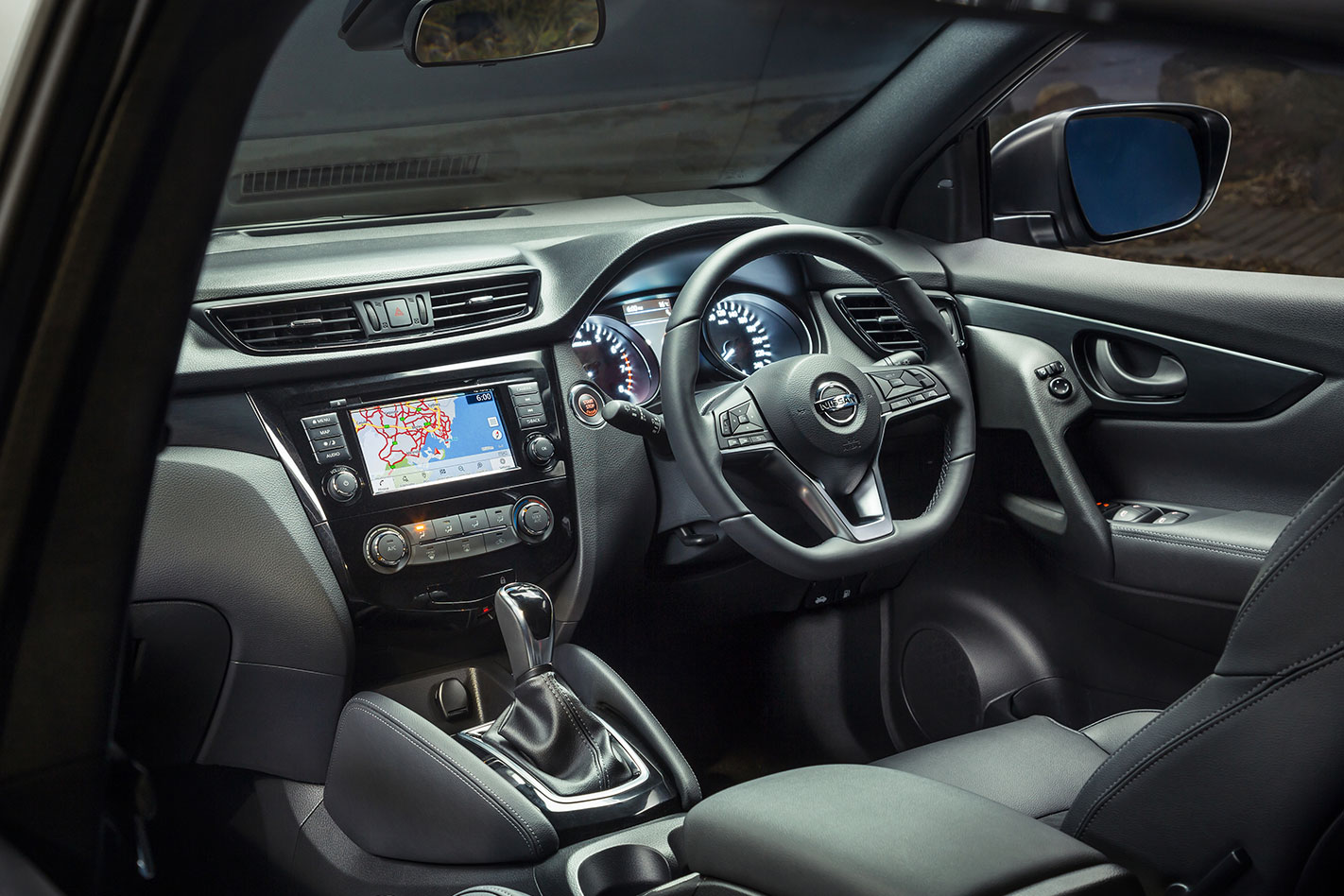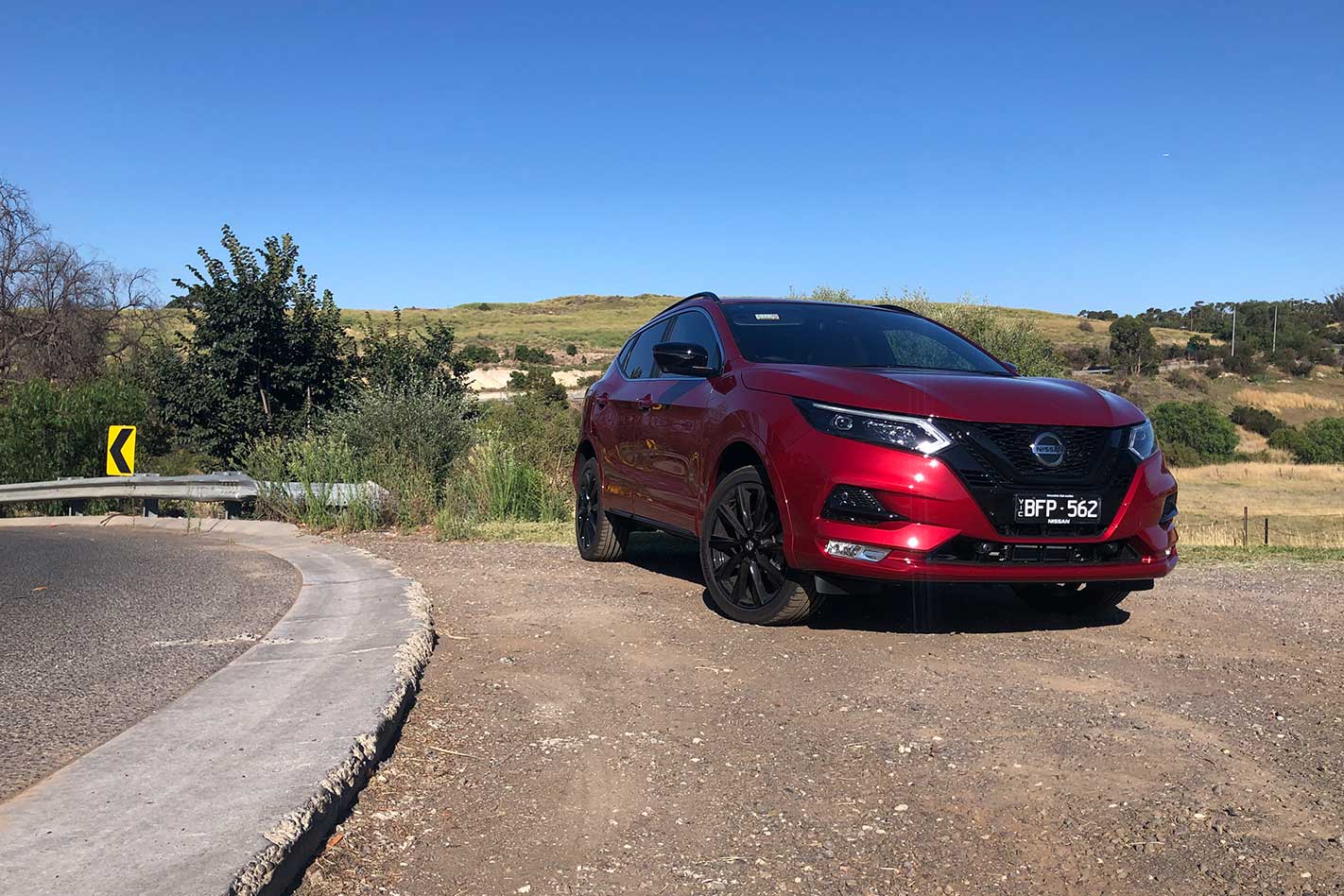
Update One: Say Hello to a Dark Prince
ODO 895km
KM Driven 372km
Average fuel use 7.7L/100km
After this year saw me leave a full-time stint at MOTOR and embark on a new role at WhichCar, it was a WhatsApp message that really drove the change home.
“We need someone to take on the Nissan Qashqai Midnight Edition,” editor Tim Robson wrote. “Keen?”

But Nissan’s five-seat small SUV offered a stark change to my last ride.
The Chevrolet Camaro ZL1 I pedalled at MOTOR had eight cylinders, while the Nissan Qashqai Midnight Edition has four.
The ZL1 produced 477kW, whereas the Qashqai is packing 106kW.
The Camaro also had 10 gears, where the CVT-equipped automatic Nissan has none (or an infinite number depending on how you look at it).
Anyway, the point is I’m in completely different territory – but I’m also relishing the chance to discover just how the Qashqai fares in the hotly contested small SUV segment.
For a bit of context, it sits just above the slightly smaller Juke in Nissan’s range, starting at just over $28,000.
It’s not dominating the sales race, but then again it’s not miserably failing either.
The nameplate’s share of sales in the small SUV category has slid from 10.5 per cent in 2015, the first full year it was available, to 7.5 per cent in 2020.

Next year an all-new model with hybrid and range-extender EV powertrains should refire buyer interest in the Qashqai.
But until then, the Midnight Edition is a way to bridge the gap.
I’m not sure whether Nissan named the Qashqai Midnight Edition ironically, given its late-life timing, but the added features certainly play up its dark side on the exterior.
Nissan has splashed gloss black across the front V-motion grille, on the bumper blades, mirror caps and roof rails.
The gloss hue also adorns interior accents and side body mouldings, matching the darkened LED taillights and headlights.
The exclusive black 19-inch wheels tie everything together nicely, and the body-coloured wheel arches and side sills add a touch of sophistication, helping it stand out in city streets.
Mind you, the Midnight Edition ain’t cheap.
At $35,290, it’s $7000 dearer than the entry-level Qashqai ST and priced into the larger X-Trail’s range.
Compared to the Qashqai ST-L variant in its own range, the Midnight Edition adds Alcantara-lined leather seats and carries over its long list of features.

And although most of these technologies are presented in what feels like an ageing cabin, the Midnight Edition does feel particularly full-fruit, even without power driver’s seat adjustment.
What strikes you immediately after settling into the front seats is how roomy the 4.4m-long five-door body feels.
I’ve covered a few kilometres in the first month I’ve had the Midnight Edition, despite spending two weeks away interstate, and it’s surprising how easily it swallows four adults.

That’ll be followed by some time in the hills, to see what Nissan’s engineers had to improve and enhance when working on the new Qashqai’s handling – while also getting to know the Qashqai in a city environment.
Stay tuned.
Update two: The Long Road (or not)
ODO 2010km
KM Driven 1115km
Average fuel use 8.55km/100km
I rarely look forward to tackling the Hume Highway.
Just before Christmas, though, when Australia’s state borders were beginning to open up, the dead straight 900km-odd drive had become a lifeline between my family unit – the dog, girlfriend and I – and loved ones in Sydney.
It would also become the Nissan Qashqai Midnight Edition’s second long-term update, focused on its highway manners during the nine-hour drive up that would magnify any strengths and weaknesses.

Unable to leave Victoria without enduring hotel quarantine on return, we replaced our Christmas lunch in Sydney with a trip down the Victorian coast.
But it wouldn’t be the only one, with repeated jaunts down the M1 West Gate freeway to Torquay planned for the summer, each offering glimpses at how the Qashqai handles the highway and high speed.
Considering this, it was a good time at the start of the holidays to check the Qashqai’s tyre pressures and learn just how much range you’ll get out of one full tank.

Should any tyre deflate, there’s a 16-inch spare lying under the boot floor.
The fuel tank, meanwhile, can accommodate an impressive 65 litres of 91 octane fuel.
With the Qashqai drinking 8.3L/100km during my city and highway driving so far, you should theoretically be able to extract 783km out of the one tank.
That’s a lot of driving.
However, while the Qashqai offers a good seating position, the pew lacks cushioning and under-thigh support, and you’ll want to spend two hours maximum in the driver’s seat before a break.

After a few trips over it, I’ve learned the Qashqai surfs the series of long, undulating dips that heavy trucks have pressed into the freeway over time with soft damping rebound, where it could almost pass as a comfortably damped sedan.
Such praise is short-lived, though, as sharp, intrusive bumps expose a much harder compression stroke. On balance, the Qashqai’s ride is tolerable enough for long distances.
I was spared navigating the Nissan’s rather old-looking infotainment with Apple CarPlay coming to the rescue, but the tyre noise that drums into the cabin prevents you from hearing a podcast clearly.
We’d put this down to a lack of sound deadening, as a guess, because the car’s 2.0-litre four-cylinder engine – codenamed M20DD – also drills a loud buzz into the cabin under acceleration.
It doesn’t sound particularly bad and quietens right down when pegged at 2000rpm for an indicated 100km/h, but just is obnoxiously loud.

Midnight Editions, despite their premium, miss out on the AEB reserved for top-spec Ti variants, and the Qashqai lacks active cruise control across the whole range.
Maintaining freeway speeds in heavy traffic becomes a game of pressing the cruise control’s Cancel and Reset buttons, something preferable to brushing my Qashqai’s brakes, which are starting to go soft on the top part of the pedal stroke.

After this, I’d recommend the Qashqai for highway driving on occasion while pointing out that its most attractive asset for long drives remains a huge boot.
At 430 litres with the rear seats up, it swallows about 210 litres more than the new Toyota Corolla, 135 more than the new Mazda 3 and 50 more than a MK7.5 VW Golf.

Seen here, it’s taken four 1.8m wooden planks in its boot along with four 60cm planks laid along the floor, as well as a 150mm PVC pipe for good measure. Impressive.
I’ll also add that the Qashqai’s air-conditioning is particularly quick to work, cooling the cabin in a matter of minutes while stationary after a start-up in 30 degrees Celsius.
Next month, though, its boot size won’t matter. I’ll uncork the Midnight Edition on twisty roads and investigate just how necessary those chunky Michelin Pilot Sport 4s are.
Update three: Turning opinions
ODO 2185km
KM Driven 175km
Average fuel use 8.32L/100km
There must be a part of every chassis engineer that dies to know most owners will never drive a car to its full potential.
I thought about this when I was reading up on the all-new Nissan Qashqai, which we understand will hit Australian shores next year.
Between its stiffer chassis and high-end suspension design, it sounds like Nissan has paid a lot of attention to how it drives.

After all, fitting a set of tyres like the Michelin Pilot Sport 4 on any car is making a statement. But Nissan didn’t spend big on rubber and then cheap out on the current Qashqai’s suspension.
Like any small hatch or SUV with a shred of handling ambition, it pairs struts up front with a multi-link rear setup and equips anti-roll bars all around.
Of course, the biggest challenge with SUVs is holding them steady as their mass sloshes around on a higher centre of gravity. Jacked-up roll centres make striking a balance between ride quality and decent handling particularly hard.
Considering this, the Qashqai’s sometimes firm ride should mean the trade-off would be half-decent handling, right? Well, sort of.

Although the road we found is far from high-speed, the Qashqai is unfazed by off-camber corners and remains planted. The flip-side of this is it also feels relatively inert from turn-in to mid-corner, failing to use the grip on offer to develop a more involving cornering stance.
Something about the Qashqai in corners feels like many Subarus, which hunker down around their ground-hugging all-wheel-drive systems.
Part of me, however, is relieved about how staid it is through corners. The Qashqai’s speed-sensitive steering fails to deliver any useful information about either the road surface or the exact angle on the front wheels.

At the end of a short blast, it’s clear the Qashqai’s not a car that you’ll wake early to find empty roads with. Considering Nissan doesn’t market it as a performance car, this shouldn’t come as a surprise, but maybe there’s an engineer in Japan that now feels vindicated.
Update four: The clock strikes midnight
ODO 2360km
KM Driven 125km
Average fuel use 10.32L/100km
After spending three months with the Nissan Qashqai Midnight Edition, our time arrived at an end.
I had planned nothing special to mark the occasion, except a trip past the servo to fill up one last time, record fuel consumption and take the Qashqai through the wash. I collected my thoughts, processing our time together.
My feeling about the break-up was neutral. I had enjoyed getting to know one of the small crossover segment’s more popular cars and was impressed it still ranked seventh in market share despite nearing nine years of age.

As a small hatchback on stilts, it’s practical. The Qashqai is one of the larger crossovers among its rivals, at 4.4m long, and that had paid dividends when needing to carry cargo or passengers.
My only wish would be for more grunt from the powertrain. That 2.0-litre atmo four-banger liked to rev, but some more low-down urge would help driveability around town where it can feel breathless in the cut-and-thrust world of rush hour.
Our 10.24L/100km overall fuel consumption is thirstier than you’d like for something with a CVT, but there was no fundamental issue with the transmission, with its subdued character suiting the car’s civil nature well.

Personally, I had come to like some little things: such as the steering wheel size and the button tactility, the dependable air conditioning, a central locking button on the front doors and rear tailgate, and the small slits in the centre glove box giving cables un-crimped passage.
While there were also things that got on my nerves: the Qashqai would beep after I locked the car, the sensitive driver’s auto window, the sole USB input hiding in the glovebox and how the reading light buttons clacked.
Ultimately, when I had to weigh up the Qashqai Midnight Edition against some rivals in my mind, it fell short of a $35,200 price tag. It has foes that are cheaper (like the MG ZS), more sophisticated (like the Mazda CX-30) and a better balance of both (Hyundai Kona).

Of course, a segment naturally begins to outperform ageing models, and that’s what has happened here. But the Qashqai still demands a look because it’s undeniably roomy and actually one of the cheaper all-wheel-drive crossovers – if that really matters.
Now we wait for the all-new car, which should make some impact with its EV-inspired powertrains when it lands early next year.
Thanks for the welcome to a new world, Qashqai. But it’s goodbye for now.




